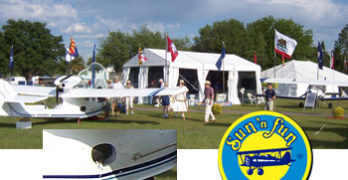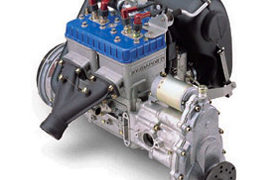Season-opening Sun ‘n Fun is crackling with excitement, enough so to make SPLOG posting a late-night effort. What a pleasure it is to be here, compared to my miss last year; thanks to many who welcomed me back! I’ve been working with Sun ‘n Fun boss John Burton regarding Light-Sport Aircraft and ultralights. John and his team provided a terrific location where LAMA and LSA Marketing Group erected a big tent, thanks to several industry sponsors*. Shiny new LSA greet everyone arriving through the main gate; airplanes are changed almost daily. I estimate 75-80% of all people attending Sun ‘n Fun view the LSA display. In addition to promoting their own products, all companies participating in the location are helping attendees find the LSA or ultralight company they wish to visit — a key reason Sun ‘n Fun offered the entrance area space. (* Sponsors include Sky Arrow USA, Sport Aircraft Works, FK Lightplanes, Jabiru USA, Fantasy Air USA, LSA America, Evektor America, BRS parachutes, Chuck Parsons, Larry Burke, and Doug Hempstead.)
Search Results for : Quicksilver
Not finding exactly what you expected? Try our advanced search option.
Select a manufacturer to go straight to all our content about that manufacturer.
Select an aircraft model to go straight to all our content about that model.
Float-Flying the M-Squared Sprint 1000
“Air in your hair!
Space on your face! A breeze on your knees!” A former colleague of mine used to repeat this short mantra to illustrate the joy of open-cockpit flying. It was catchy and engaging and his customers liked it.
With 15 Light-Sport Aircraft now possessing their FAA Special Light-Sport Aircraft (SLSA) airworthiness certificates, not a single one is open cockpit, though the IndUS Thorpedo, Legend Cub, and Tecnam Sierra can enjoy partially open cockpits.
Special Light-Sport Aircraft will eventually add more of this genre of light aircraft but one of the beauties of FAA’s new regulation is that it does not eliminate two previous categories: Amateur-built 51% kits or Part 103-compliant ultralights.
With 21¼4 years left before operators of 2-seat 496-pound empty weight ultralight exempt trainers must register in FAA’s new Light-Sport Aircraft category, and with 41¼4 years left while these machines can be used for compensated training flights, the segment still has lots of life remaining.
LSA Market Shares Based on FAA Registry
Lots of people want to know…customers, insurance companies, dealers, membership organizations, and, of course, all the manufacturers and importers. We all like to keep score. While I believe FAA data has some delay in reporting, it is a reputable source of info. Here’s what their registrations show through the end of March, 2007. *** Flight Design remains #1 at 21% — #2 American Legend remains the largest U.S. producer with 13% of all registrations. These two are followed by #3 Evektor at 8% — #4 TL Ultralights (StingSport) at 7% — #5 Tecnam at 6% — #6 Fantasy Air at 6% — #7 AMD (CH-601) at 5% — #8 LSA America (Skyboy) at 4% — #9 CubCrafters at 4% — and #10 Jabiru at 3% of all SLSA registrations. These aircraft account for 552 aircraft or 77% of 719 registered SLSA airplanes.
U.S. Built A-22 Valor Wins SLSA #49
After I flew the A-20 and A-22 near Aeroprakt’s Ukraine factory, I felt sure these designs would find their way to the U.S. market. Now that Sebring-based Float Planes and Amphibs (FPNA) assumed import operations from Spectrum Aircraft, you can buy planes like the great-flying A-20 Vista or the tractor engine amphib A-24 Viking. FPNA also builds an amphibious float system for trikes and sells other lines like Quicksilver ultralights and powered parachutes. *** But their newest achievement on March 31st, a couple weeks before Sun ‘n Fun 2007, was SLSA approval for the A-22 Valor. FPNA is the manufacturer of this model, purchasing the fuselage and selected other components from designer Aeroprakt in Ukraine, but building 60% of the airplane themselves including wings, avionics and panel work, engine installation, plus all plumbing and electrical. FPNA owner Shawn Okun says the Orlando MIDO office gave their approval.
The Lil’ Breezy B-Model
Open-Cockpit 2-seater
ust when you felt as though Light-Sport Aircraft (LSA) was the only segment of aviation getting any press, along comes a flying machine that harks back to the early days of ultralighting but with a distinctive fuselage construction and composite wings.
Just when it seemed like every new LSA had to be enclosed, four-stroke-powered, fast, and have leather seats, along comes a new open-cockpit, mile-a-minute airplane that can easily carry two people on the power of a 50-hp Rotax 503. The leather is on your flight jacket.
The Lil’ Breezy B can weigh 350 pounds empty, fly at 60 mph, and sell for $12,500 (for all parts plus engine/prop but not your assembly labor). In my experience that sounds like an ultralight. Born in the new millennium, the Lil’ Breezy B is a modern ultralight.
Before we go fly, let’s examine the machine and talk to its developer, Jack Harper.
Flight Design CT2K
A Bold Yet Efficient Euro-Designed Light-Sport Aircraft
Flightstar imports the CT2K in anticipation of the light-sport aircraft rule.
As FAA’s proposed light-sport aircraft
rule looms ever closer, one
of the first aircraft that will likely
fit the field and be recognized by American
pilots is Germany’s CT. For the U.S.
market, and with a nod to the new millennium,
producer Flight Designs has
renamed the model as the CT2K.
“CT” stands for Composite Twoseater.
It is certainly not alone in being
“white, glass, and built overseas,” a
theme that emerged at EAA AirVenture
Oshkosh 2002. But the design was a
leader in the move from tube-and-rag
ultralights to the modern microlights of
Europe. And it distinguishes itself in a
number of ways that we’ll explore in
this review.
My experiences flying the CT on two
occasions were both with Europeanbased
check pilots. The most recent
opportunity was with Allistair Wilson,
formerly a major with the Royal Irish
Regiment in Northern Ireland.
Buckeye Convertible
I never really noticed before just how much the Buckeye Industries powered parachute carriage looked like a trike carriage. Maybe you didn’t either, but in your mind’s eye, remove the prop guard and see if you don’t agree. They aren’t identical, of course, but the visual relationship is uncannily close considering the two aircraft types developed separately.
What a perfect situation. Ralph Howard’s family members and friends have built Buckeye from “nothing” to one of the world’s largest aircraft manufacturers, all in the ’90s and without even using the entire decade! Whatever combination of talent, money, timing and luck was involved in this tale of success, the Howards want to keep it going strong. That won’t be easy, but these Indiana Hoosiers may be up to the task.
Take the momentum of a reported several hundred powered parachute units sold each of the last few years. Revise the hardware slightly to expand into the manufacture of trikes, and you have a potent mixture that could emerge as one of America’s largest trike builders.
Eye On the Sky Watch
There was a time when a company called Beaver RX Enterprises – which produced the Canadian Beaver designs – was among the leading North American ultralight manufacturers.
In particular, the Beaver 550 tandem 2-seater attracted many customers. The company once claimed more than 3,500 ultralights flying. Certainly the model dominated the western Canadian market but also had a presence in the U.S. and other countries.
The old Beaver RX Enterprises company went through a number of leadership changes and, driven by overly-ambitious management goals, finally succumbed.
When I visited the now defunct company, the firm was a publicly-held corporation listed on the Vancouver Stock Exchange. Even the stock exchange has experienced a transformation, so perhaps it isn’t surprising that Beaver RX Enterprises also lost its heading.
As we’ve seen with other good designs, however – such as Quicksilvers, Phantoms or Drifters – the better ultralights can outlast their ownership. The Beaver line is among those survivors.
Lightweight Four-Stroke HKS Now Available for LSA
After Rotax announced ASTM compliance for their lightweight 582 two-stroke engine, many American pilots celebrated. This lighter, simpler powerplant (compared to the 9-series engines) gave ultralight builders seeking SLSA certification more flexibility while significantly lowering cost for buyers. Now HKS enters the arena issuing a Statement of Compliance for the horizontally opposed, twin-cylinder, four-stroke, 60-hp 700E engine. HKS is lighter than four-cylinder engines and can save buyers several thousand dollars. American importer HPower has assisted at least 29 companies as they became HKS-powered, including such leading names as RANS, Quicksilver, Murphy, Earthstar, CGS, Titan, ASAP, and Flightstar. The Japanese company, HKS Aviation Co., Ltd., made their declaration on July 16, one month after the Rotax 582. Behind HKS Aviation is real depth in a 400-employee company active in high-performance auto components. I’ve flown a number of airplanes with this engine and have become converted to its smooth power.
Rotax Certifies 582; Good for American Designs?
Perhaps a long time coming Austria-based Rotax recently certified the 65-horsepower R-582 two-stroke engine under ASTM standards. Now, some American designs may proceed with pursuing their Special Light-Sport Aircraft approval. One that pops into my mind immediately is Quicksilver‘s already-certified GT500 (under Primary Catetory from the mid-1990s) but many more could be close behind…for example, powered parachutes and other popular American ultralights. While most SLSA are hitting the gross weight limit of 1,320 pounds, LSA aren’t required to be that heavy so the 65-horse engine could be a most appropriate powerplant. One interesting note is that if A&Ps currently resist working on the 912 series what will they think of two-stroke engines? A swing factor could be Cessna, should the big company choose the lightweight 9-series Rotax over a Lycoming (part of Cessna’s corporate family). If Cessna goes Rotax, then the door may open to mechanic acceptance.
- « Previous Page
- 1
- …
- 14
- 15
- 16
- 17
- 18
- …
- 21
- Next Page »











